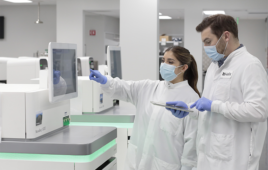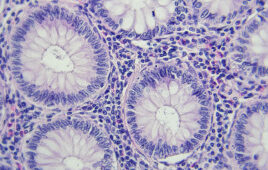A topical microbicide that silences two genes can safely protect against genital herpes infection for as long as one week, according to a joint study by researchers at the Albert Einstein College of Medicine of Yeshiva University and Harvard Medical School.
The study, carried out in mice, represents a major step toward developing a vaginal microbicide that offers women protection against herpes infection. Such a microbicide might also help in controlling the AIDS epidemic, since the blisters caused by genital herpes make people more susceptible to HIV infection. The study’s principal investigators were Deborah Palliser, Ph.D., assistant professor of microbiology & immunology at Einstein and Judy Lieberman, M.D., Ph.D., professor of pediatrics, Harvard Medical School.
The microbicide in this study is based on RNA interference (RNAi), a mechanism cells use to protect their genetic machinery from viruses and other threats. RNAi employs short, double-stranded RNAs called small interfering RNAs, or siRNAs. In 2001, scientists discovered that synthetic siRNAs can induce RNA interference in mammalian cells — a finding that has triggered interest in harnessing this strategy for biomedical research and drug development.
The HSV-2 microbicide used in this study inactivates two genes via RNA interference. One siRNA targets a viral gene, thereby silencing virus immediately following application, but suppression lasts for only a couple of days. The second siRNA — specific for a cell-surface protein used by HSV-2 to dock onto cells it infects — takes a few days to silence the gene, but then confers suppression for a week.
By combining the fast-acting-but-short-lived RNAi with the slower-acting-but-long-lived RNAi, the researchers created a vaginal microbicide offering protection that was both immediate (even warding off an HSV-2 “challenge” given shortly before the microbicide was applied) and sustained (protecting against HSV-2 challenge for a week after application).
‘A good microbicide for a sexually transmitted disease must offer long-term protection — compliance will be problematic if it has to be applied immediately before sexual intercourse,’ says Dr. Palliser. ‘Our microbicide, with its two siRNAs, provided sustained and uninterrupted protection against HSV-2 infection. And equally important, we achieved these results without causing inflammation of vaginal tissue — a side effect observed with other siRNAs that also risks neutralizing a microbicide’s benefits. We’re hopeful that this experimental microbicide can be turned into a cost-effective therapy for use in developing countries where up to 80 percent of the population is infected with HSV-2.’ The researchers are currently working to refine the microbicide and as yet have no plans for clinical trials.
Release Date: January 21, 2009
Source: Albert Einstein College of Medicine
Filed Under: Genomics/Proteomics



